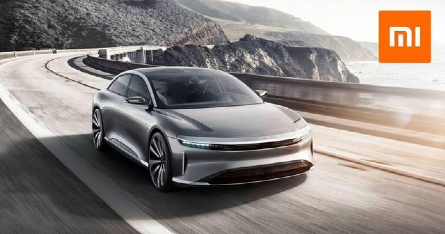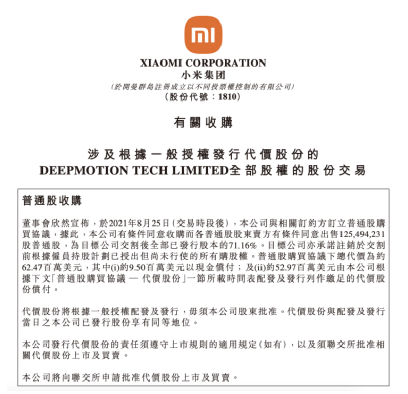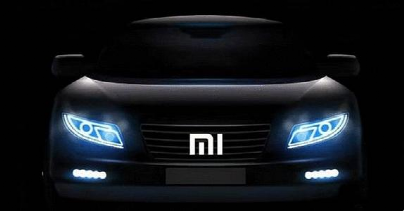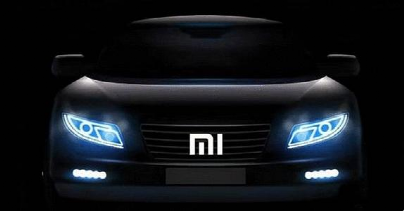Introduction
Since Xiaomi announced its entry into the automotive industry, speculation about how Xiaomi will conduct its car business has been ongoing, and Xiaomi has never disclosed the exact car manufacturing partner. Recently, Xiaomi has made another move. We found on QCC that Zhejiang Konghui Automotive Technology Co., Ltd. has undergone industrial and commercial changes, with the addition of a shareholder, Hubei Xiaomi Yangtze River Industry Fund Partnership Enterprise (limited partnership). At the same time, the registered capital of the company has increased from about RMB 13.3 million to about RMB 14 million.
Most people may not be familiar with the company that Xiaomi has newly invested in. Public information shows that Zhejiang Konghui Automotive Technology Co., Ltd. was established on October 9, 2018, with its scope of business including: development, integration, matching, and sales of automotive electronic suspension systems. With the investment in this supplier of electronic suspension systems, Xiaomi has also accelerated the progress of car manufacturing. By means of investment, acquisition, and other capital means, Xiaomi has quickly integrated the resources of the industrial chain, which can be said to be determined in the matter of car manufacturing. So, what is the latest development of Xiaomi’s car manufacturing? What problems and challenges may it face in the future? This article provides three guesses about Xiaomi’s future car manufacturing road.
Xiaomi’s Car Manufacturing Model
As a mobile phone hardware company, Xiaomi is obviously far from the automotive industry, especially in the traditional industry where the automobile has a relatively mature global supply chain system and technology. As a newcomer to the industry, Xiaomi will not spend too much effort in unfamiliar areas. I think Xiaomi’s car manufacturing model is likely to be similar to Apple’s. That is, Xiaomi is responsible for product R&D and design and outsources manufacturing to third parties. After all, from the current perspective, Xiaomi’s main advantage is indeed concentrated on the software part, and from hardware to mass production, they are not currently strong. Therefore, the approach chosen by Xiaomi, designing themselves + cooperating with partner for manufacturing, may be the most suitable and lowest risk choice at the beginning.
In fact, as early as the end of April of this year, there was news that Xiaomi had in-depth discussions with Borgward in car manufacturing, but the negotiations were stopped abruptly due to the significant difference in valuations between the two parties. Currently, the Borgward automobile has gradually faded from public view. Not only have some stores quietly closed, but the factory has also stopped production for a period of time. The updates of some social media accounts are also stuck in 2020. Public data shows that Borgward automobile sold only 8,740 vehicles in 2020, breaking through the threshold of 10,000 vehicles, and capacity is in a serious surplus. In addition, there are rumors that Xiaomi will acquire the factory of Beiqi, but they have not been confirmed by Xiaomi officials.
 Recently, Lei Jun and his team went to China FAW Group in Geelyn Province to conduct in-depth negotiations on cooperation matters, and they were also received by the Secretary of the Geelyn Provincial Party Committee and the Governor. This move is speculated by the outside world as Xiaomi’s hope to set up a car factory in Northeast China, which has caused a carnival in the Northeast. As one of the most important components of China’s auto industry, Northeast China has a good industrial foundation, strong research and development capabilities, and sufficient talent reserves. It is not difficult to understand Xiaomi’s choice of FAW. Just yesterday, with Xiaomi’s investment in Konhui Automotive, it further confirmed that Xiaomi will not spend more effort in areas where it is not good at. As one of the first domestic companies to successfully mass produce electric control air suspension systems, Konhui Automotive’s help to Xiaomi with less car factory experience is huge.
Recently, Lei Jun and his team went to China FAW Group in Geelyn Province to conduct in-depth negotiations on cooperation matters, and they were also received by the Secretary of the Geelyn Provincial Party Committee and the Governor. This move is speculated by the outside world as Xiaomi’s hope to set up a car factory in Northeast China, which has caused a carnival in the Northeast. As one of the most important components of China’s auto industry, Northeast China has a good industrial foundation, strong research and development capabilities, and sufficient talent reserves. It is not difficult to understand Xiaomi’s choice of FAW. Just yesterday, with Xiaomi’s investment in Konhui Automotive, it further confirmed that Xiaomi will not spend more effort in areas where it is not good at. As one of the first domestic companies to successfully mass produce electric control air suspension systems, Konhui Automotive’s help to Xiaomi with less car factory experience is huge.
From the current news, it seems that choosing partners to build cars for it should not be a big problem for Xiaomi, and various places are very interested in joining hands with Xiaomi. Will Xiaomi ultimately leave the car-making completely to more professional car factories, or integrate the automotive industry supply chain and hold the car-making process in its own hands, which can only be answered by Xiaomi’s official response.
Xiaomi’s Focus on Car-Making
If it can acquire a car factory or find an OEM factory to make cars for it, Xiaomi can focus more on its strengths, which is technology and software, and in the automotive field, nothing is more worthy than autonomous driving. In just 5 months, Xiaomi has formed a team of about 300 people for autonomous driving, and Lei Jun himself has personally promoted Xiaomi’s car business on social media to attract talent.
In addition to hiring people, Xiaomi has also embarked on a buying spree. After announcing that it will produce cars, Xiaomi successively invested in Zongmu Technology, Hesai Technology, Geometry Partner, Aibocar and DeepMotion, integrating ADAS systems, lidars, millimeter-wave radars and intelligent parking into Xiaomi’s autonomous driving platform, solving the core hardware problems related to autonomous driving integration. It is worth noting that Xiaomi completed the full acquisition of DeepMotion and will serve as Xiaomi’s flagship company in the field of autonomous driving, undoubtedly the brightest. DeepMotion will take on the task of integrating other component suppliers and become Xiaomi’s system-level technology exporter in the field of autonomous driving. According to relevant information, DeepMotion has proven its ability in forward/surround/360-degree perception system, autonomous valet parking AVP solution, map positioning, and perception. Xiaomi acquired this company for only 500 million yuan, which seems to be a very cost-effective investment.
 # Xiaomi’s Position in the Car Industry
# Xiaomi’s Position in the Car Industry
It is clear that Xiaomi has wisely focused its main efforts on its area of expertise. By expanding its autonomous driving team and acquiring companies with mature solutions, Xiaomi’s development in autonomous driving has been remarkably rapid. As a latecomer to the market, Xiaomi’s fastest and most effective way to catch up to its competitors is to rapidly build its team and acquire existing technology, although no company has yet produced a perfect solution. With its own advantages, Xiaomi has a great opportunity to come from behind.
Xiaomi’s Car-making Positioning
Xiaomi, which focuses on L4 level autonomous driving, has an obvious high-end positioning in car-making. As we all know, the sensors for autonomous driving currently cost tens of thousands of yuan and are not available on low-end models. Therefore, will the Xiaomi car that focuses on autonomous driving be unable to achieve a cost-effective positioning?
Actually, Lei Jun had previously revealed in a live broadcast that Xiaomi might respect the wishes of its fans and position its first car as a sedan or SUV in the 100,000 to 300,000 yuan range, symbolizing middle to high-end models. However, based on online surveys, more rice flour hoped that Xiaomi would continue to adhere to its cost-effective strategy. 30% of the netizens hoped that Xiaomi’s car pricing would be below 100,000 yuan. After the announcement of car-making, there was an online outcry for “the first car for young people.”
However, if Xiaomi indeed chooses a car model below 100,000 yuan, not only may it damage Xiaomi’s brand image, but how will Xiaomi solve the cost issue of autonomous driving? In addition, at present, when low-end electric vehicles are occupying a large share of the market, such as the Wuling Hongguang MINI EV, Chery Small Ant, and Euler series, what will Xiaomi do to compete with them? For example, the solid car manufacturing capabilities and strong fan effect of the Wuling Hongguang MINI EV have created a unique car model. Xiaomi lacks the hardware foundation and resources of traditional car manufacturers, making it even more difficult to control costs if it wants to highlight its smart ecosystem advantages. Therefore, it seems that the cost-effective strategy is difficult to implement for Xiaomi.However, let’s not forget how Xiaomi opened up the market with its early smartphones. In a market where phones sold for thousands, it seemed impossible for a low-end phone priced at just 1000 yuan to have any high-end features, but Xiaomi managed to gain a loyal following by offering affordable prices with high value. Can Xiaomi replicate this success in the field of new energy vehicles, allowing young users to enjoy high-end self-driving experiences without breaking the bank? Xiaomi must think carefully about the positioning of its car, as it is crucial for its success in the automotive industry.
Conclusion
Xiaomi’s goal in making cars is not just about making cars, but about achieving a closed-loop smart ecosystem and delivering a complete smart ecosystem experience to users. Therefore, Xiaomi cannot develop in isolation and must infuse its philosophy and culture into its car-making process. Although Xiaomi started with affordability as its selling point, it also saw how a long-term focus on low-end phones hindered its transition to high-end phones in the mobile phone industry. For Xiaomi’s car project, it should learn from this experience; “the first car for young people” does not necessarily mean a low-priced car model. Xiaomi can create “the first car for young people”, but it should align with the preferences of its current users, emphasizing technology and exquisite design that caters to the tastes of the younger generation. Only then can Xiaomi carve a unique path for itself in the fiercely competitive new energy vehicle market.

This article is a translation by ChatGPT of a Chinese report from 42HOW. If you have any questions about it, please email bd@42how.com.
